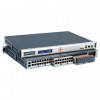Lantronix SLC 8000 Advanced Console Manager User Guide - Page 77
Hostname & Name Servers, DNS Servers, DHCP-Acquired DNS Servers, TCP Keepalive Parameters
 |
View all Lantronix SLC 8000 Advanced Console Manager manuals
Add to My Manuals
Save this manual to your list of manuals |
Page 77 highlights
6: Basic Parameters Ethernet Bonding Ethernet Bonding Status (Link) Reverse Path Filter Ethernet 1 and Ethernet 2 can be bonded to support redundancy (Active Backup), aggregation (802.3ad), and load balancing. Disabled by default. Note that if Ethernet Bonding is enabled, assigning individual IP Addresses to Device Ports is not supported. Click the link to access Ethernet bonding status information. Ethernet 1 and Ethernet 2 can be bonded to support redundancy (Active Backup), aggregation (802.3ad), and load balancing. Disabled by default. Note that if Ethernet Bonding is enabled, assigning individual IP Addresses to Device Ports is not supported. Click Back to Network Settings link to return to the Network Settings page. Select this option to allow the Reverse Path Filter mode, which is defined in RFC 3704. In this mode, each incoming packet is tested against the forwarding information base (FIB), and if the network interface is not the best reverse path, the packet check will fail and failed packets are discarded. Note: Configurations with the same IP subnet on multiple interfaces (Ethernet or PPP) are not currently supported. Hostname & Name Servers Hostname Domain The default host name is slcXXXX, where XXXX is the last 4 characters of the hardware address of Ethernet Port 1. There is a 64-character limit (contiguous characters, no spaces). The host name becomes the prompt in the command line interface. If desired, specify a domain name (for example, support.lantronix.com). The domain name is used for host name resolution within the SLC unit. For example, if abcd is specified for the SMTP server, and mydomain.com is specified for the domain, if abcd cannot be resolved, the SLC 8000 advanced console manager attempts to resolve abcd.mydomain.com for the SMTP server. DNS Servers #1 - #3 Configure up to three name servers with an IPv4 or IPv6 address. #1 is required if you choose to configure DNS (Domain Name Server) servers. The SLC will attempt to contact each DNS server in the order that they are given. If a DNS server cannot be reached, the next DNS server will be tried. If a DNS server is reachable, but does not resolve a hostname, no other attempts will be mad to resolve the hostname using the remaining DNS servers. The first three DNS servers acquired via DHCP through Eth1 and/or Eth2 display automatically. DHCP-Acquired DNS Servers #1 - #3 Prefer IPv4 DNS Records Displays the IP address of the name servers if automatically assigned by DHCP. If enabled, IPv4 DNS records will be preferred when DNS hostname lookups are performed. Otherwise IPv6 records will be preferred (when IPv6 is enabled). Enabled by default. TCP Keepalive Parameters Start Probes Number of seconds the SLC unit waits after the last transmission before sending the first probe to determine whether a TCP session is still alive. The default is 600 seconds (10 minutes). SLC™ 8000 Advanced Console Manager User Guide 77















